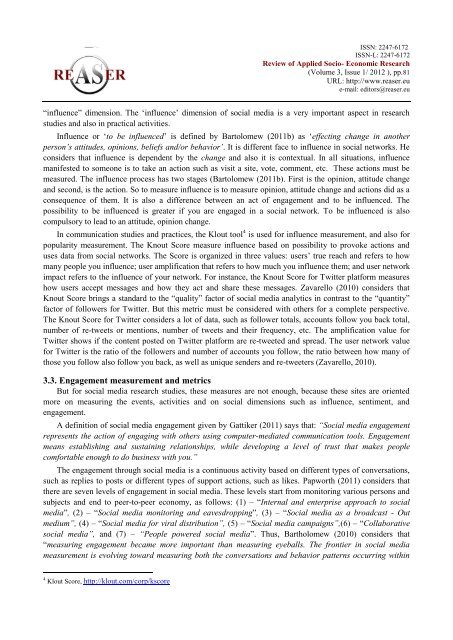Volume 3, ISSUE1/2012 - Review of Applied Socio-Economic ...
Volume 3, ISSUE1/2012 - Review of Applied Socio-Economic ...
Volume 3, ISSUE1/2012 - Review of Applied Socio-Economic ...
Create successful ePaper yourself
Turn your PDF publications into a flip-book with our unique Google optimized e-Paper software.
ISSN: 2247-6172<br />
ISSN-L: 2247-6172<br />
<strong>Review</strong> <strong>of</strong> <strong>Applied</strong> <strong>Socio</strong>- <strong>Economic</strong> Research<br />
(<strong>Volume</strong> 3, Issue 1/ <strong>2012</strong> ), pp.81<br />
URL: http://www.reaser.eu<br />
e-mail: editors@reaser.eu<br />
“influence” dimension. The ‘influence’ dimension <strong>of</strong> social media is a very important aspect in research<br />
studies and also in practical activities.<br />
Influence or ‘to be influenced’ is defined by Bartolomew (2011b) as ‘effecting change in another<br />
person’s attitudes, opinions, beliefs and/or behavior’. It is different face to influence in social networks. He<br />
considers that influence is dependent by the change and also it is contextual. In all situations, influence<br />
manifested to someone is to take an action such as visit a site, vote, comment, etc. These actions must be<br />
measured. The influence process has two stages (Bartolomew (2011b). First is the opinion, attitude change<br />
and second, is the action. So to measure influence is to measure opinion, attitude change and actions did as a<br />
consequence <strong>of</strong> them. It is also a difference between an act <strong>of</strong> engagement and to be influenced. The<br />
possibility to be influenced is greater if you are engaged in a social network. To be influenced is also<br />
compulsory to lead to an attitude, opinion change.<br />
In communication studies and practices, the Klout tool 4 is used for influence measurement, and also for<br />
popularity measurement. The Knout Score measure influence based on possibility to provoke actions and<br />
uses data from social networks. The Score is organized in three values: users’ true reach and refers to how<br />
many people you influence; user amplification that refers to how much you influence them; and user network<br />
impact refers to the influence <strong>of</strong> your network. For instance, the Knout Score for Twitter platform measures<br />
how users accept messages and how they act and share these messages. Zavarello (2010) considers that<br />
Knout Score brings a standard to the “quality” factor <strong>of</strong> social media analytics in contrast to the “quantity”<br />
factor <strong>of</strong> followers for Twitter. But this metric must be considered with others for a complete perspective.<br />
The Knout Score for Twitter considers a lot <strong>of</strong> data, such as follower totals, accounts follow you back total,<br />
number <strong>of</strong> re-tweets or mentions, number <strong>of</strong> tweets and their frequency, etc. The amplification value for<br />
Twitter shows if the content posted on Twitter platform are re-tweeted and spread. The user network value<br />
for Twitter is the ratio <strong>of</strong> the followers and number <strong>of</strong> accounts you follow, the ratio between how many <strong>of</strong><br />
those you follow also follow you back, as well as unique senders and re-tweeters (Zavarello, 2010).<br />
3.3. Engagement measurement and metrics<br />
But for social media research studies, these measures are not enough, because these sites are oriented<br />
more on measuring the events, activities and on social dimensions such as influence, sentiment, and<br />
engagement.<br />
A definition <strong>of</strong> social media engagement given by Gattiker (2011) says that: “Social media engagement<br />
represents the action <strong>of</strong> engaging with others using computer-mediated communication tools. Engagement<br />
means establishing and sustaining relationships, while developing a level <strong>of</strong> trust that makes people<br />
comfortable enough to do business with you.”<br />
The engagement through social media is a continuous activity based on different types <strong>of</strong> conversations,<br />
such as replies to posts or different types <strong>of</strong> support actions, such as likes. Papworth (2011) considers that<br />
there are seven levels <strong>of</strong> engagement in social media. These levels start from monitoring various persons and<br />
subjects and end to peer-to-peer economy, as follows: (1) – “Internal and enterprise approach to social<br />
media”, (2) – “Social media monitoring and eavesdropping”, (3) – “Social media as a broadcast - Out<br />
medium”, (4) – “Social media for viral distribution”, (5) – “Social media campaigns”,(6) – “Collaborative<br />
social media”, and (7) – “People powered social media”. Thus, Bartholomew (2010) considers that<br />
“measuring engagement became more important than measuring eyeballs. The frontier in social media<br />
measurement is evolving toward measuring both the conversations and behavior patterns occurring within<br />
4 Klout Score, http://klout.com/corp/kscore








